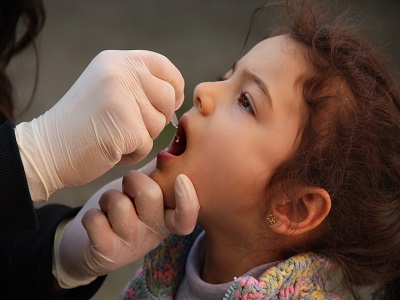Cover image: © UNICEF/UN01324/Yurtsever
Immunization plays a critical role in achieving global health goals. However its broader value is still underestimated. Sometimes it is also underappreciated, especially when Adverse Events Following Immunization (AEFI) occur. This AEFI Communication eLearning course aims to help Immunization Partners and their counterpart Government Officials to identify a public health concern that arises from immunization, gauge its potential impact, and design and manage an appropriate communication response. The course content comprises basic communication preparedness and response concepts, approaches and tools. It has been produced in collaboration with WHO and CDC to ensure highest quality standards, extending the already ongoing WHO & UNICEF Immunization e-learning initiative.
Objectives
The broad objective is to support immunization partners and EPI/C4D staff to have better communication preparedness and response capacity to address safety concerns at national and sub-national levels. At the end of this eLearning communication course, the participants will be able to adequately:
- Explain AEFI and possible scenarios.
- Match possible AEFI scenarios to a local context.
- Define preparedness approaches.
- Identify processes and tools used to design, roll out and monitor an AEFI communication response.
- Describe and apply the communication components, techniques, IPC capacity, partnerships and steps involved in managing a crisis.
Audience
The course is intended for immunization partners and EPI/C4D staff on vaccine safety communication preparedness and responding to AEFI. The course is available publicly, and to countries using innovative and affordable technologies.
Length
In addition to an introductory (zero) module, the course has three modules with a total duration of 75 minutes – Module 1 (15 minutes), Module 2 (25 minutes) and Module 3 (35 minutes).
Methodology
The three animated modules follow AEFI response approach and various AEFI case studies that unravel through a series of learning activities designed to emulate some of the tasks Immunization partners and EPI/C4D officials would normally undertake to identify, prepare for and respond to an AEFI. While completing these learning activities, the participants have access to relevant communication resources.
Each module is divided into micro-lessons corresponding to a key activity of the identification, preparation or response processes. Each lesson is divided into topics covered through interactive presentations, animation and exploration activities that not only engage the participants, but also allow them to work on different subject matters at their own pace. A couple of formative evaluation questions provide the participants opportunity to test their understanding at the end of each module.
The key content is drawn from a WHO developed guide on Vaccine Safety Events: Managing the Communication Response, UNICEF’s working paper on Building Trust and Responding To Adverse Events Following Immunization In South Asia: Using Strategic Communication and other related material.
Structure
The course includes the following three key modules:
Module 1: Anatomy of AEFI – Duration 15 Minutes
- Identifying an AEFI and its causes
- Identifying an AEFI-related crisis
Module 2: Planning a Communication Response to AEFIs - Duration 25 Minutes
- AEFI communication essentials
- Communication plan
- Partnerships
Module 3: Implementing and Managing the Communication Response - Duration 35 Minutes
- Deciding to communicate
- Communicating with media
- Communicating with caregivers and communities
- Dealing with rumours
- Monitoring and evaluation
Additional Resources
- AEFI Reporting Form
- CDC Crisis and Emergency Communication 2014
- EDC Communication on Immunization – Building Trust 2012
- UNICEF Building Trust and Responding To Adverse Events Following Immunization In South Asia: Using Strategic Communication, 2005
- WHO Vaccine Safety Communication – Guide for National Programme Managers and National Regulatory Authorities, 2013
- WHO Vaccine Safety Events: Managing the Communications Response, 2013
- Sample AEFI Communication Planning Template
Contact details
Surangani Abeyesekera, Communication for Development Specialist, Health Section, UNICEF NYHQ, sabeyesekera@unicef.org
